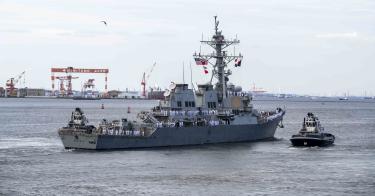The U.S. Navy will soon release a new force design plan that has the potential to agitate for action or dissolve in ebbing confidence to meet the China threat. Which will it be?
Force design plans are the Navy’s outlines of its capabilities, such as warships and munitions, and technologies it will rely on to meet evolving security threats abroad. These plans set the basis for major investment decisions. The last force design was in 2023 and required 381 ships.
Today, the Navy’s fleet numbers 291 warships. Had the last congressionally mandated goal of 355 warships (set in 2016 and supported through three administrations) been executed, today’s fleet should number 313 warships. We can blame this 22-warship deficit on inconsistent political priorities, not the lack of a plan.
The executive summary of the 2016 report stated that the U.S. Navy needed 653 warships to meet the requirements of geographic combatant commands, such as Indo-Pacific Command and European Command. Eliminating redundancies, the real requirement became 459 warships.
>>> Nine for the Navy: Proposals to Accelerate a Delayed Naval Buildup
Because of budget considerations, a compromise fleet of 355 warships was finally agreed to. As this occurred, China grew its fleet to more than 370 warships while the U.S. Navy added a net 16 to its fleet.
Budget-led planning has failed to ensure that our Navy actually paced the China threat. A threat-informed force design is required if there is any intention of meeting and deterring the threat of war this decade in the so-called 2027 Davidson Window.
Of course, numbers alone are not enough, but they help get the ordnance within the target range. As I argued last October, if on Inauguration Day, President Trump placed a hold on all planned retirements of naval warships with service life left, the fleet would grow to 333 at best by Inauguration Day 2029. So, how can the forthcoming force design be assessed?
It must show how the U.S. Navy will get firepower to sea. Nothing can be done to reverse the decline, which reaches a nadir at peak danger in 2027, but the plan can mitigate this. One way is to rapidly field new optionally manned vessels such as the USV Ranger, which successfully launched an SM-6 missile in September 2021 and could be quickly stationed within the Tomahawk cruise missile range of China.
Second, and perhaps most urgent, the new force design must show how the Navy so equipped can operate in new ways to deter and defeat China by 2027. Continuation of business-as-usual operations, budgeting and planning has failed. Congress, the White House and the U.S. Navy must embrace this reality and make needed organizational changes.
>>> America’s Maritime Revival: Sailing Into Some Headwinds
One way is to reestablish the First Fleet and focus it on the decisive maritime theater of the South China Sea. Another is to shepherd the AUKUS (Australia, United Kingdom and U.S.) nuclear submarine project, which will begin having American submarines rotationally based in Australia in 2027, adding firepower closer to the threat.
Finally, and critically, the Navy’s new plan must include a maritime industrial revival if the nation hopes to compete and win in the new cold war. In short, the ships the Navy orders this year and next must include demands for shipbuilding capacity growth. Using novel contracting mechanisms, such as the proposed SAWS (Services Acquisition Workshop), matched with congressional legislative incentives, such as a distributed profits tax, can incentivize capital investments for shipbuilding capacity over pleasing Wall Street.
If the Navy’s next force design meets these three key metrics while being executable, then it should be viewed as worthy. What we need more than a plan, though, is action and the delivery of meaningful results in the next two years. That’s the real metric of success.
This piece originally appeared in The Washington Times




